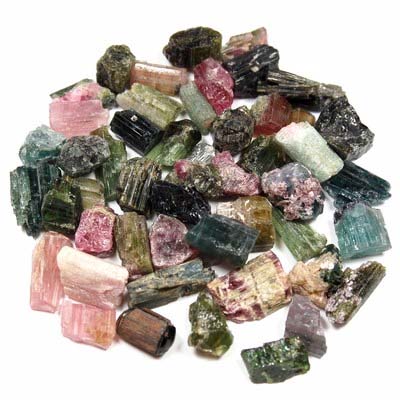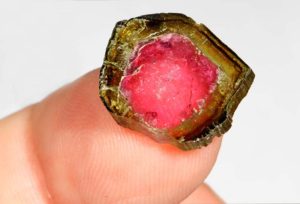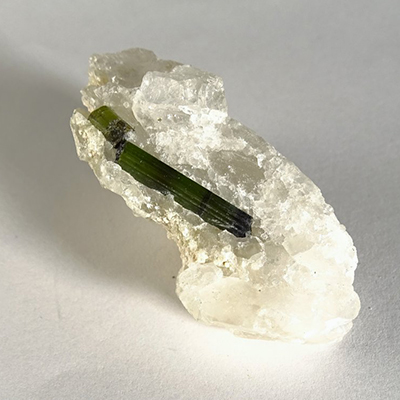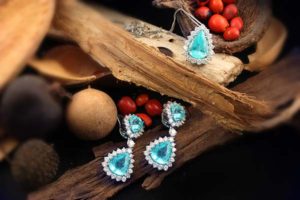The most colorful crystal group in the world
The name tourmaline comes from the Sinhalese word “turamali” and means multicolored stone.
Available in almost all colors and shades, from colorless to black. This makes it so unique compared to other mineral groups.
“Tourmaline” is the name of a large group of borosilicate minerals. It includes minerals that have the same crystal structure and similar physical properties, but differ in chemical composition in addition to the constant constituents. Accordingly, the colors are also different.

Tourmaline color range

Melon tourmaline
In common parlance, melons tourmaline whose core has a pink or reddish tinge and the shell is green. Such stones are usually polished in cross-section on slabs to make their special color combination visible.
Monochrome tourmalines are quite rare. It is common for several colors or shades to be found within a mineral, even different from layer to layer.
By heating (450-650 degrees) some color change can be achieved: the green stones will be emerald colored and the reddish browns will turn bright red.
In common parlance, melons tourmaline whose core has a pink or reddish tinge and the shell is green. Such stones are usually polished in cross-section on slabs to make their special color combination visible.
Monochrome tourmalines are quite rare. It is common for several colors or shades to be found within a mineral, even different from layer to layer.
By heating (450-650 degrees) some color change can be achieved: the green stones will be emerald colored and the reddish browns will turn bright red.

Melon tourmaline
The crystals belonging to the tourmaline group are also named after their colors, for example:
- Acroit (Greek word), colorless
- Rubellite (its name means red in Latin), from pink to red, the most valuable is the ruby color
- Drávit (named after the Drava River), yellowish brown to dark brown
- Verdelit (its name comes from the Italian-Greek word – “green stone”), all shades of green
- Indigolite (named after its color), all shades of blue
- Sörl (name refers to the old German mining term – “fake ore”), black

Verdelit
Crystal characteristics
Most commonly, prismatic crystals are found that have a triangular cross-section and rounded sides. The longitudinal banding of the prisms is characteristic.
It is glass-gloss on the crystal plates and wax-gloss on the fracture surfaces.
Tourmaline crystals were formed when hot waters and vapors carried the chemical elements necessary for crystal formation into cavities or rock fractures, thus providing adequate space for crystal growth. Tourmaline is a hard mineral, so it remains relatively intact in sediment and sedimentary rocks despite the damaging effects of streams, rivers and seawater. They can also avoid long distances from their site of formation.
Tourmaline history
Tourmaline has been known and used since ancient times. For example, archaeologists have found a seal made of tourmaline, which dates from the AD e. It dates from the 3rd or 2nd century and is believed to depict Alexander the Great. It has been used by American Indians for centuries as a funeral gift.
It was not until 1703 that the Dutch East India Company imported brightly colored Ceylon tourmaline into Europe.
Throughout its millennial history, until the 1800s, when modern mineralogy was formed, the multicolored crystal was identified with some other mineral, e.g. with emerald, ruby or topaz.
Special properties of tourmaline
Pyroelectricity: occurs when, upon cooling after heating, the crystal receives an electric charge with opposite poles at both ends.
The Dutch were aware of this effect. They removed the ash from their crotch pipes with heated tourmaline, hence the name “aschentrekker”, the ash puller. For a long time, this was the official name for tourmaline. Due to the pyroelectric effect, it needs to be cleaned more often than other gemstones.
Piezoelectricity: for pressure or upon rubbing, the crystal receives an electric charge. In this case, it attracts dust particles or even pieces of paper. The rock crystal has the same property, only the effect is even stronger.

California miners in the 1850s
Honnan származik
Az 1800-as évek 2. felében, az 1900-as évek elején az USA élenjárt a turmalin-bányászatban.
Kalifornia számos részén találtak gazdag lelőhelyeket, ahonnan sok drágakő minőségű kristályok került elő.
Napjainkban a legtöbb turmalin Brazíliából származik, de nagy mennyiség található Afganisztánban, Ausztráliában, Indiában, Kenyában, Kongóban, Madagaszkáron stb. Európában az Elba mentén és Svájcban lehet turmalinokat találni.
Industrial use of tourmaline
Its piezoelectric properties are mainly used in pressure measuring devices. e.g. to detect and measure changes in pressure conditions in depth gauges or other equipment based on sound reflection. It is used for polarized light tests in optical devices.
Jewelry gem
Tourmaline’s high brightness, hardness and huge range of colors make it a sought-after gemstone. Perhaps the most special of all is the jewelry adorned with paraiba tourmaline.

Paraiba tourmaline
The bright, neon blue color of this natural crystal is unmatched. It got its name from a Brazilian state where it was first found in the 1980s.
Tourmaline, because of its wide range of colors, is a favorite mineral and gemstone for many, so it’s no surprise that this particular crystal proved to be the most popular of the three nominees in the Mineral of the Year 2020 vote. In 2020, this special mineral group will be at the heart of all our mineral exchanges. We present it to those interested in photo and mineral exhibitions, as well as scientific lectures.


